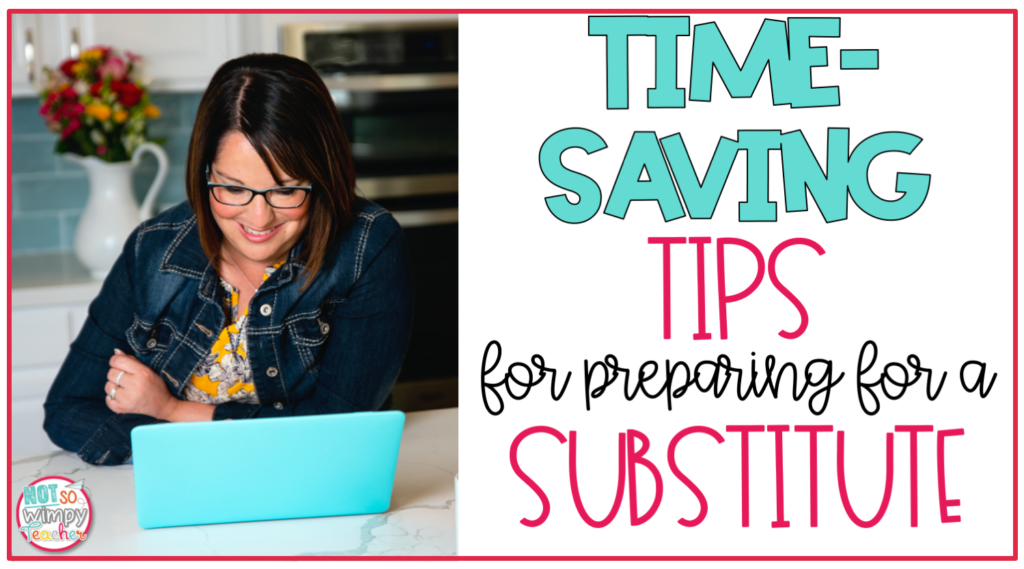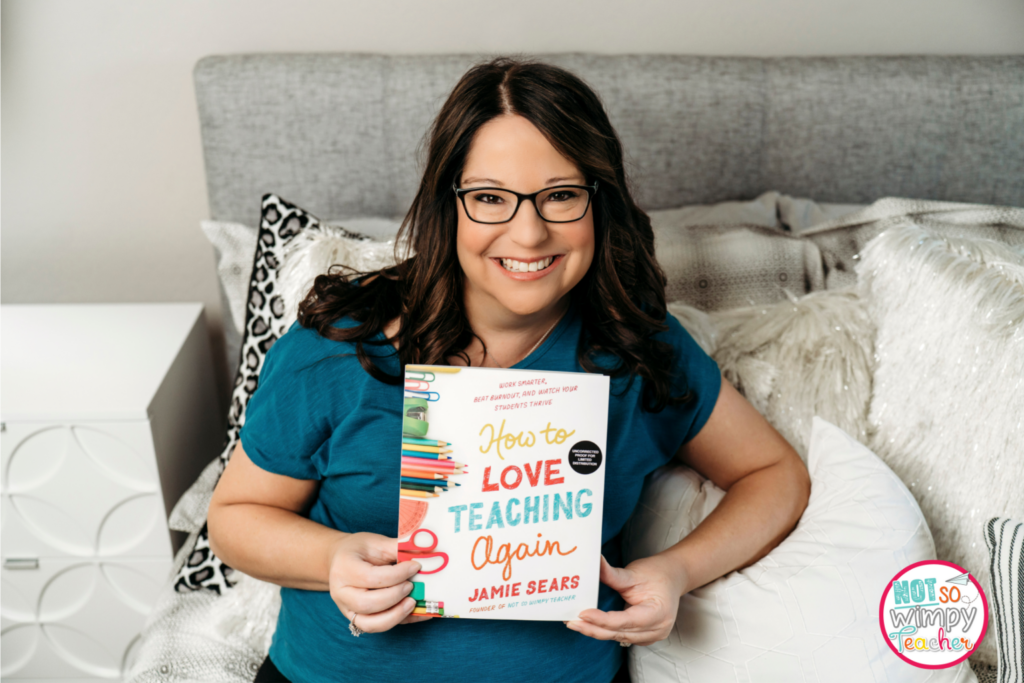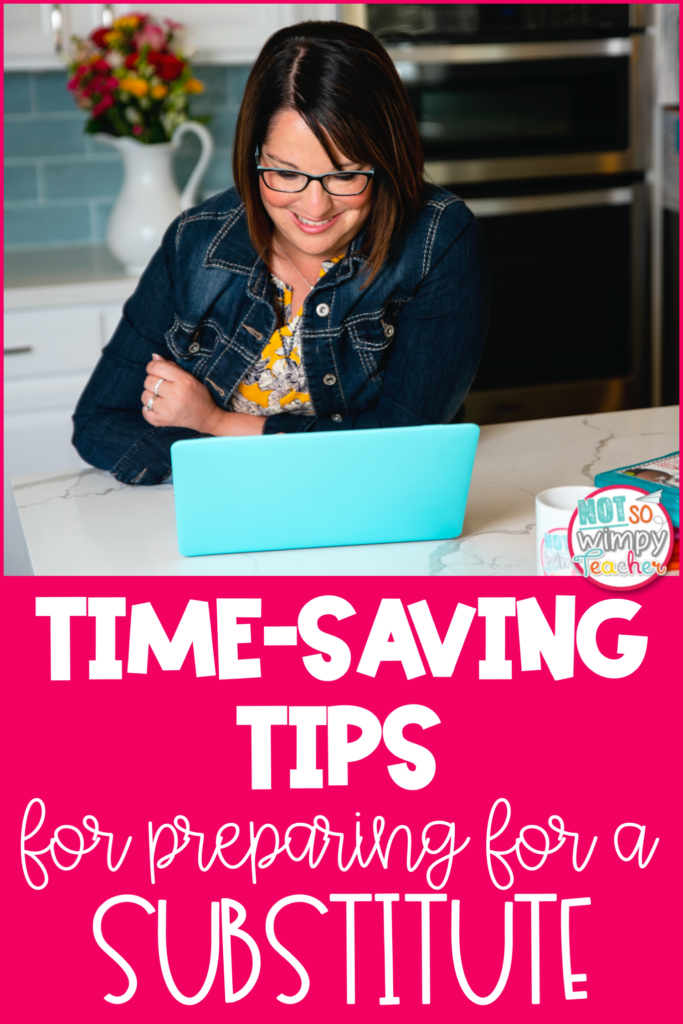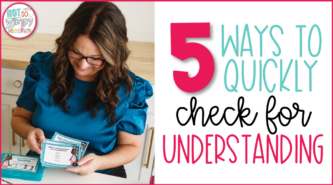
A lot of teachers think it’s easier to go to school sick than it is to get ready for a substitute. In fact, the general sentiment is that “Preparing for a substitute is the worst!”
I know the feeling. I remember it well. But still, the fact that teachers would rather go to school sick than call off hurts my heart.
First of all, in the age of COVID, this is not a good idea. In fact, it was never a good idea, but our toxic “must work hard at all times” brainwashed us into thinking that staying home when we are ill makes us weak. You really do need to rest and relax (and keep your germs to yourself), so that you can get well quickly.
There are also a million other reasons why you might need or want to take a day off: sick children, doctors appointments, funerals, conferences, your mental health . . . You get the time off, so you might as well take it. Today I’m sharing some time-saving tips for preparing for a substitute.
1. Stick with your normal routine
This is both the easiest tip and the hardest when preparing for a substitute. I mean, it’s easy because you have already planned for your regular routine. You have practiced it all year. And your students know it.
But, it can be scary to think about someone you don’t know trying to teach that lesson about fractions or the main idea of a paragraph. Yikes! It’s hard to trust important, challenging lessons to others.
And then there are those lessons you look forward to teaching every year. Maybe you always look forward to the lesson on building arrays or writing alliterations, and you don’t want to give it up to someone else. Or maybe your favorite read aloud is on the plans for tomorrow. Do you really want to miss sharing The One and Only Ivan with the class?
My advice is to let all of this go. Your best bet for a successful day with a substitute, not to mention keeping up with the pacing guide, is to follow the normal schedule. Every time you introduce a new activity or shake up the routine, you invite chaos into the classroom.
Plus, you don’t have the time or energy to be planning new activities when you are sick. Just stick with what you planned. And remember, you’ve taught your students well. Trust them to follow the procedures you’ve been practicing together all year.
2. Prewrite your minute-to-minute classroom routine
Now let’s talk for a minute about those lesson plans.
My second tip for preparing for a substitute teacher is to prewrite your minute-to-minute classroom routine for each day of the week. If you have a daily template with the times of all of your subjects, specials, lunch, recess, pullouts, etc . . . already written out, you will be so far ahead of the game when you need to take a day off.
Create a document for each day of the week. Then, when you write your lesson plans, all you have to do is add book titles, page numbers, materials, or any special details for each subject/block of time.
This document is a great resource for you to use throughout the week, and it is ready and waiting for a last-minute substitute. You can even include notes next to the sections or on the bottom as necessary. I like to include student birthdays, classroom volunteers, assemblies, etc…
This will save you so much time preparing for a substitute. And you will be especially grateful for the planning ahead when you or your kiddos are under the weather.
Want a ready-made template you can use? I’ve created an editable substitute plan template that will make planning for a sub easier than you ever imagined. And you can grab it for FREE when you order my book How to Love Teaching Again.

3. Create a special behavior incentive
This last tip can help ensure that the time you spend preparing for a substitute is not wasted.
Even the best-behaved class can fall off the rails when the teacher is absent. So why not come up with a special plan to reduce the risk of that happening? A special behavior incentive is very motivating to your students.
This can be as simple as adding some extra incentives to your behavior plan. You can try adding something new that your kiddos haven’t seen before. Or go with something they really love and will be on the best behavior to earn.
Maybe you reward the kids with smelly pencils or a piece of candy. Or you could offer extra recess or a day where they can choose their own seats. The key is making these incentives available only when there is a substitute teacher.
Draw a circle on a piece of chart paper and challenge the kids to earn petals with their good behavior. Each time the substitute catches them being good, they can add a petal to the flower. Determine in advance how many petals are needed for each reward.
Of course, you can use any symbol that’s easy to draw. Try switching it up with the seasons: a turkey with feathers, a tree with ornaments, a heart with stars, etc. . . .
If you know in advance that you will be out, you can talk about the behavior plan and special incentives with your class before you leave. It is helpful to review your classroom rules and expectations and make sure your students know that the same routines apply even when there is a guest teacher. This ensures that everyone is on the same page and the students are prepared to meet expectations.
How to Love Teaching Again

If you loved these tips for preparing for a substitute, I know you will love my book How to Love Teaching Again.
In it, I share tips for setting boundaries, increasing productivity, and finding the fulfillment you crave as a teacher. You’ll find even more practical ideas for preparing for a substitute, as well as strategies to help you conquer classroom routines, save time planning and grading, and make teaching more fun.
Of course, it’s peppered with funny stories and real-life examples to make it a quick and fun read.
You’ll also get these three AWESOME bonuses:
- Book Club Kit: Want to host a book club at your school? This Book Club Kit includes a calendar of events, suggested reading schedule, reflection questions, and tips for implementing the most important strategies in each chapter!
- Yearlong Pacing Guides for grades 2-5: If you teach grades 2-5, you can just download and go! If not, these are great examples of how to create your own yearlong pacing guide and save yourself a ton of stress and time. Either way, they are pure gold.
- Editable Sub Plan Templates: From daily schedule to lesson plan template to classroom behavior plan and more, these templates include everything you need to plan for a sub without breaking a sweat. (In both digital and printable formats!) And the great thing is, most of these pages can be done in advance. So when you need to take a day off, you’ve got everything all ready to go!

I hope these tips help you feel more confident about taking a little time off this year.
Have a Not So Wimpy Day,


















 End of Year Carnival Week for grades 2-5!
End of Year Carnival Week for grades 2-5!
I flew through your book after a friend recommended it. It was an easy read FULL of easy-to-implement strategies. A few of the strategies are ones that I actually do, so the affirmation I received while reading was confidence-building. Thank you for sharing your amazing strategies, techniques, and philosophies!
You’re welcome! I’m so glad you enjoyed it!
I recently bought and read your book…LOVE IT!!! I am very interested in trying batch planning this year, as I move to a new grade level. With each week (week 1: plan math for five weeks, week 2: plan reading for five weeks, etc), what am I teaching in science, social studies, and grammar, and writing, since I haven’t “batch planned” for them yet? Or do I plan all of this before school starts? I might be misunderstanding. Thank you for clarifying.